Nissan XTrail T30 2005 User Manual

A GENERAL INFORMATION
SECTION GI
GENERAL INFORMATION
CONTENTS
GI
B
C
D
E
PRECAUTIONS ......................................................... |
3 |
Description .............................................................. |
3 |
Precautions for Supplemental Restraint System |
|
(SRS) “AIR BAG” and “SEAT BELT PRE-TEN- |
|
SIONER” ................................................................. |
3 |
Precautions for NVIS/IVIS (NISSAN/INFINITI |
|
VEHICLE IMMOBILIZER SYSTEM - NATS) (If |
|
Equipped) ................................................................ |
3 |
General Precautions ............................................... |
4 |
Precautions for Three Way Catalyst ........................ |
5 |
Precautions for Fuel (Unleaded Regular Gasoline |
|
Recommended) ....................................................... |
5 |
Precautions for Multiport Fuel Injection System or |
|
Engine Control System ........................................... |
6 |
Precautions for Hoses ............................................. |
6 |
HOSE REMOVAL AND INSTALLATION .............. |
6 |
HOSE CLAMPING ............................................... |
6 |
Precautions for Engine Oils ..................................... |
7 |
HEALTH PROTECTION PRECAUTIONS ............ |
7 |
ENVIRONMENTAL PROTECTION PRECAU- |
|
TIONS .................................................................. |
7 |
Precautions for Air Conditioning .............................. |
7 |
HOW TO USE THIS MANUAL .................................. |
8 |
Description .............................................................. |
8 |
Terms ...................................................................... |
8 |
Units ........................................................................ |
8 |
Contents .................................................................. |
8 |
Components ............................................................ |
9 |
SYMBOLS ............................................................ |
9 |
How to Follow Trouble Diagnoses ......................... |
10 |
DESCRIPTION ................................................... |
10 |
HOW TO FOLLOW TEST GROUPS IN TROU- |
|
BLE DIAGNOSES .............................................. |
10 |
HARNESS WIRE COLOR AND CONNECTOR |
|
NUMBER INDICATION ....................................... |
11 |
KEY TO SYMBOLS SIGNIFYING MEASURE- |
|
MENTS OR PROCEDURES .............................. |
12 |
How to Read Wiring Diagrams .............................. |
14 |
CONNECTOR SYMBOLS .................................. |
14 |
SAMPLE/WIRING DIAGRAM - EXAMPL - ........ |
15 |
DESCRIPTION ................................................... |
16 |
Abbreviations ......................................................... |
22 |
SERVICE INFORMATION FOR ELECTRICAL INCI- |
|
DENT ........................................................................ |
23 |
How to Check Terminal ........................................... |
23 |
CONNECTOR AND TERMINAL PIN KIT ........... |
23 |
HOW TO PROBE CONNECTORS ..................... |
23 |
How to Perform Efficient Diagnosis for an Electrical |
|
Incident .................................................................. |
26 |
WORK FLOW ..................................................... |
26 |
INCIDENT SIMULATION TESTS ....................... |
26 |
CIRCUIT INSPECTION ...................................... |
29 |
Control Units and Electrical Parts .......................... |
34 |
PRECAUTIONS ................................................. |
34 |
CONSULT-II CHECKING SYSTEM ......................... |
36 |
Description ............................................................. |
36 |
Function and System Application .......................... |
36 |
Nickel Metal Hydride Battery Replacement ........... |
36 |
Checking Equipment ............................................. |
37 |
CONSULT-II Start Procedure ................................. |
37 |
CONSULT-II Data Link Connector (DLC) Circuit ... |
38 |
INSPECTION PROCEDURE ............................. |
39 |
LIFTING POINT ........................................................ |
40 |
Special Service Tools ............................................ |
40 |
Garage Jack and Safety Stand .............................. |
40 |
2-Pole Lift .............................................................. |
41 |
BoardOn Lift ........................................................ |
42 |
TOW TRUCK TOWING ............................................ |
43 |
Tow Truck Towing .................................................. |
43 |
2WD MODELS .................................................... |
43 |
AWD MODELS ................................................... |
44 |
Vehicle Recovery (Freeing a Stuck Vehicle) .......... |
44 |
TIGHTENING TORQUE OF STANDARD BOLTS ... |
45 |
Description ............................................................. |
45 |
Tightening Torque Table (New Standard Included)... |
45 |
PREVIOUS STANDARD .................................... |
45 |
NEW STANDARD BASED ON ISO .................... |
46 |
DISCRIMINATION OF BOLTS AND NUTS ........ |
47 |
RECOMMENDED CHEMICAL PRODUCTS AND |
|
F
G
H
I
J
K
L
M
Revision: 2005 March |
GI-1 |
2005 X-Trail |

SEALANTS .............................................................. |
48 |
Recommended Chemical Products and Sealants... |
48 |
IDENTIFICATION INFORMATION ........................... |
49 |
Model Variation ...................................................... |
49 |
IDENTIFICATION NUMBER ............................... |
50 |
IDENTIFICATION PLATE ................................... |
50 |
ENGINE SERIAL NUMBER ............................... |
51 |
AUTOMATIC TRANSAXLE NUMBER ................ |
51 |
MANUAL TRANSAXLE NUMBER ...................... |
51 |
Dimensions ............................................................ |
51 |
Wheels & Tires ....................................................... |
51 |
TERMINOLOGY ....................................................... |
52 |
SAE J1930 Terminology List .................................. |
52 |
Revision: 2005 March |
GI-2 |
2005 X-Trail |

PRECAUTIONS
PRECAUTIONS |
PFP:00001 |
Description |
AAS000NC |
Observe the following precautions to ensure safe and proper servicing. These precautions are not described in each individual section.
GI
B
Precautions for Supplemental Restraint System (SRS) “AIR BAG” and “SEAT BELT PRE-TENSIONER” AAS000OL
The Supplemental Restraint System such as “AIR BAG” and “SEAT BELT PRE-TENSIONER”, used along with a front seat belt, helps to reduce the risk or severity of injury to the driver and front passenger for certain types of collision. Information necessary to service the system safely is included in the SRS and SB section of this Service Manual.
C
D
WARNING:
●To avoid rendering the SRS inoperative, which could increase the risk of personal injury or death
in the event of a collision which would result in air bag inflation, all maintenance must be performed by an authorized NISSAN/INFINITI dealer.
●Improper maintenance, including incorrect removal and installation of the SRS, can lead to per-
sonal injury caused by unintentional activation of the system. For removal of Spiral Cable and Air Bag Module, see the SRS section.
●Do not use electrical test equipment on any circuit related to the SRS unless instructed to in this
Service Manual. SRS wiring harnesses can be identified by yellow and/or orange harnesses or harness connectors.
E
F
G
Precautions for NVIS/IVIS (NISSAN/INFINITI VEHICLE IMMOBILIZER SYSTEM - NATS) (If Equipped) AAS000NE
NVIS/IVIS (NATS) will immobilize the engine if someone tries to start it without the registered key of NVIS/IVIS (NATS).
Both of the originally supplied ignition key IDs have been NVIS/IVIS (NATS) registered.
The security indicator is located on the instrument panel. The indicator blinks when the immobilizer system is functioning.
Therefore, NVIS/IVIS (NATS) warns outsiders that the vehicle is equipped with the anti-theft system.
●When NVIS/IVIS (NATS) detects trouble, the security indicator lamp lights up while ignition switch is in "ON" position.
This lighting up indicates that the anti-theft is not functioning, so prompt service is required.
●When servicing NVIS/IVIS (NATS) (trouble diagnoses, system initialization and additional registration of other NVIS/IVIS (NATS) ignition key IDs), CONSULT-II hardware and CONSULT-II NVIS/IVIS (NATS) software is necessary.
Regarding the procedures of NVIS/IVIS (NATS) initialization and NVIS/IVIS (NATS) ignition key ID registration, refer to CONSULT-II operation manual, NVIS/IVIS (NATS).
Therefore, CONSULT-II NVIS/IVIS (NATS) software (program card and operation manual) must be kept strictly confidential to maintain the integrity of the anti-theft function.
●When servicing NVIS/IVIS (NATS) (trouble diagnoses, system initialization and additional registration of other NVIS/IVIS (NATS) ignition key IDs), it may be necessary to re-register original key identification. Therefore, be sure to receive all keys from vehicle owner. A maximum of four or five key IDs can be registered into NVIS/IVIS (NATS).
●When failing to start the engine first time using the key of NVIS/IVIS (NATS), start as follows.
1.Leave the ignition key in "ON" position for approximately 5 seconds.
2.Turn ignition key to "OFF" or "LOCK" position and wait approximately 5 seconds.
3.Repeat step 1 and 2 again.
4.Restart the engine while keeping the key separate from any others on key-chain.
H
I
J
K
L
M
Revision: 2005 March |
GI-3 |
2005 X-Trail |
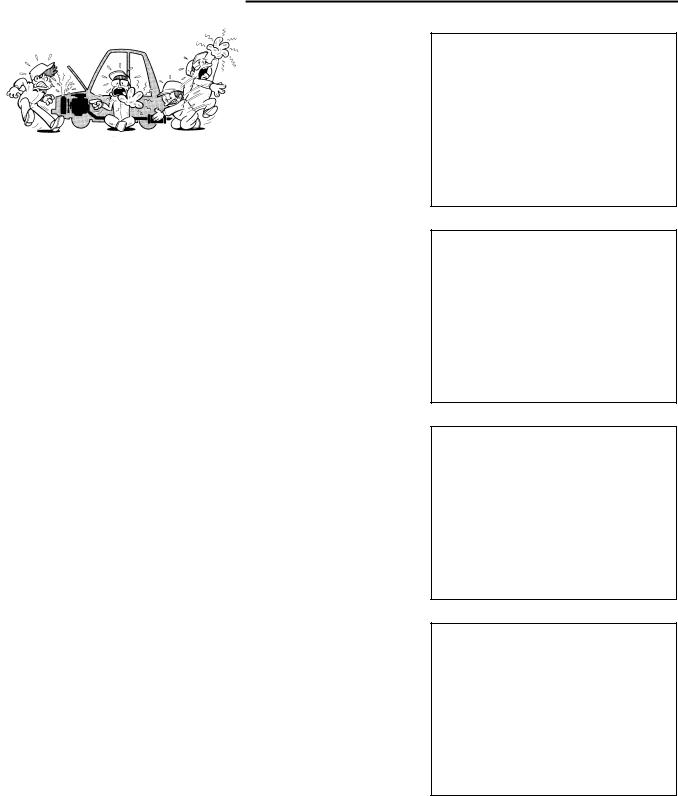
PRECAUTIONS
General Precautions |
AAS000NF |
●Do not operate the engine for an extended period of time without proper exhaust ventilation.
Keep the work area well ventilated and free of any inflammable materials. Special care should be taken when handling any inflammable or poisonous materials, such as gasoline, refrigerant gas, etc. When working in a pit or other enclosed area, be sure to properly ventilate the area before working with hazardous materials.
Do not smoke while working on the vehicle.
SGI285
●Before jacking up the vehicle, apply wheel chocks or other tire blocks to the wheels to prevent the vehicle from moving. After jacking up the vehicle, support the vehicle weight with safety stands at the points designated for proper lifting before working on the vehicle.
These operations should be done on a level surface.
●When removing a heavy component such as the engine or transaxle/transmission, be careful not to lose your balance and drop them. Also, do not allow them to strike adjacent parts, especially the brake tubes and master cylinder.
●Before starting repairs which do not require battery power: Turn off ignition switch.
Disconnect the negative battery terminal.
●If the battery terminals are disconnected, recorded memory of radio and each control unit is erased.
SGI231
SEF289H
●To prevent serious burns:
Avoid contact with hot metal parts.
Do not remove the radiator cap when the engine is hot.
●Dispose of drained oil or the solvent used for cleaning parts in an appropriate manner.
●Do not attempt to top off the fuel tank after the fuel pump nozzle shuts off automatically.
Continued refueling may cause fuel overflow, resulting in fuel spray and possibly a fire.
●Clean all disassembled parts in the designated liquid or solvent
prior to inspection or assembly. |
SGI233 |
|
●Replace oil seals, gaskets, packings, O-rings, locking washers, cotter pins, self-locking nuts, etc. with new ones.
●Replace inner and outer races of tapered roller bearings and needle bearings as a set.
●Arrange the disassembled parts in accordance with their assembled locations and sequence.
●Do not touch the terminals of electrical components which use microcomputers (such as ECM). Static electricity may damage internal electronic components.
●After disconnecting vacuum or air hoses, attach a tag to indicate the proper connection.
●Use only the fluids and lubricants specified in this manual.
Revision: 2005 March |
GI-4 |
2005 X-Trail |

PRECAUTIONS
●Use approved bonding agent, sealants or their equivalents when required.
●Use hand tools, power tools (disassembly only) and recommended special tools where specified for safe and efficient service repairs.
●When repairing the fuel, oil, water, vacuum or exhaust systems, check all affected lines for leaks.
PBIC0190E
●Before servicing the vehicle:
Protect fenders, upholstery and carpeting with appropriate covers.
Take caution that keys, buckles or buttons do not scratch paint.
SGI234
WARNING:
To prevent ECM from storing the diagnostic trouble codes, do not carelessly disconnect the harness connectors which are related to the engine control system and TCM (transmission control module) system. The connectors should be disconnected only when working according to the WORK FLOW of TROUBLE DIAGNOSES in EC and AT sections.
Precautions for Three Way Catalyst |
AAS000NG |
If a large amount of unburned fuel flows into the catalyst, the catalyst temperature will be excessively high. To prevent this, follow the instructions.
●Use unleaded gasoline only. Leaded gasoline will seriously damage the three way catalyst.
●When checking for ignition spark or measuring engine compression, make tests quickly and only when
necessary.
●Do not run engine when the fuel tank level is low, otherwise the engine may misfire, causing damage to the catalyst.
Do not place the vehicle on flammable material. Keep flammable material off the exhaust pipe and the three way catalyst.
Precautions for Fuel (Unleaded Regular Gasoline Recommended) |
AAS000OQ |
Use unleaded regular gasoline with an octane rating of at least 87 AKI (Anti-Knock Index) number (Research octane number 91).
CAUTION:
Do not use leaded gasoline. Using leaded gasoline will damage the three way catalyst. Using a fuel other than that specified could adversely affect the emission control devices and systems, and could also affect the warranty coverage validity.
GI
B
C
D
E
F
G
H
I
J
K
L
M
Revision: 2005 March |
GI-5 |
2005 X-Trail |
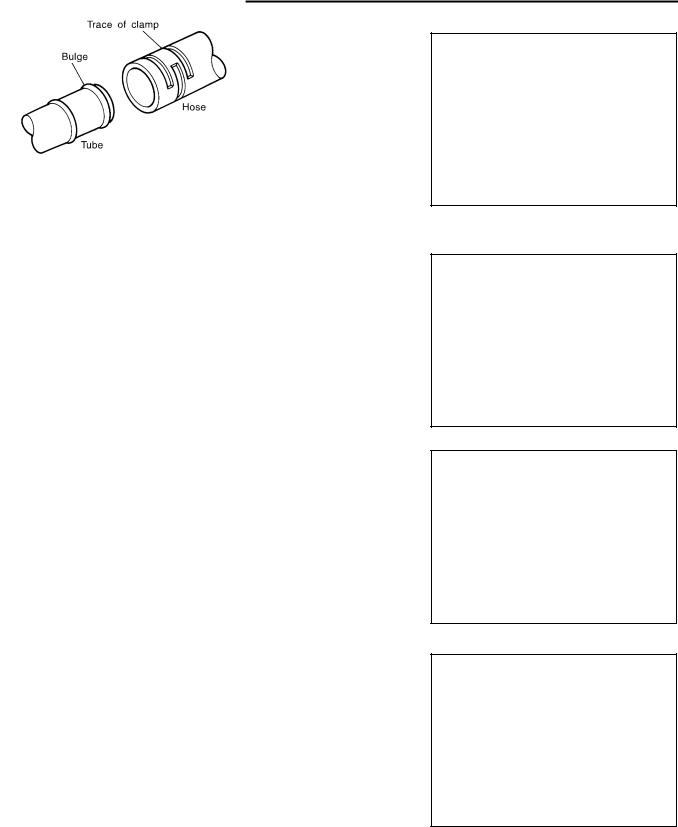
PRECAUTIONS
Precautions for Multiport Fuel Injection System or Engine Control System AAS000NI
●Before connecting or disconnecting any harness connector for the multiport fuel injection system or ECM:
Turn ignition switch to “OFF” position. Disconnect negative battery terminal. Otherwise, there may be damage to ECM.
●Before disconnecting pressurized fuel line from fuel pump to injectors, be sure to release fuel pressure.
●Be careful not to jar components such as ECM and mass air flow sensor.
Precautions for Hoses
HOSE REMOVAL AND INSTALLATION
●To prevent damage to rubber hose, do not pry off rubber hose with tapered tool or screwdriver.
SGI787
AAS000NJ
SMA019D
●To reinstall the rubber hose securely, make sure that hose insertion length and orientation is correct. (If tube is equipped with hose stopper, insert rubber hose into tube until it butts up against hose stopper.)
SMA020D
HOSE CLAMPING
●If old rubber hose is re-used, install hose clamp in its original position (at the indentation where the old clamp was). If there is a trace of tube bulging left on the old rubber hose, align rubber hose at that position.
●Discard old clamps; replace with new ones.
SMA021D
Revision: 2005 March |
GI-6 |
2005 X-Trail |

PRECAUTIONS
●After installing plate clamps, apply force to them in the direction of the arrow, tightening rubber hose equally all around.
|
SMA022D |
Precautions for Engine Oils |
AAS000NK |
Prolonged and repeated contact with used engine oil may cause skin cancer. Try to avoid direct skin contact with used oil.
If skin contact is made, wash thoroughly with soap or hand cleaner as soon as possible.
HEALTH PROTECTION PRECAUTIONS
● Avoid prolonged and repeated contact with oils, particularly used engine oils. ● Wear protective clothing, including impervious gloves where practicable.
● Do not put oily rags in pockets.
● Avoid contaminating clothes, particularly underpants, with oil.
● Heavily soiled clothing and oil-impregnated footwear should not be worn. Overalls must be cleaned regularly.
● First aid treatment should be obtained immediately for open cuts and wounds.
● Use barrier creams, applying them before each work period, to help the removal of oil from the skin.
● Wash with soap and water to ensure all oil is removed (skin cleansers and nail brushes will help). Preparations containing lanolin replace the natural skin oils which have been removed.
● Do not use gasoline, kerosene, diesel fuel, gas oil, thinners or solvents for cleaning skin. ● If skin disorders develop, obtain medical advice without delay.
●Where practical, degrease components prior to handling.
●Where there is a risk of eye contact, eye protection should be worn, for example, chemical goggles or face
shields; in addition an eye wash facility should be provided.
ENVIRONMENTAL PROTECTION PRECAUTIONS
Dispose of used oil and used oil filters through authorized waste disposal contractors to licensed waste disposal sites, or to the waste oil reclamation trade. If in doubt, contact the local authority for advice on disposal facilities.
It is illegal to pour used oil on to the ground, down sewers or drains, or into water sources. The regulations concerning pollution vary between regions.
Precautions for Air Conditioning |
AAS000NL |
GI
B
C
D
E
F
G
H
I
J
K
L
M
Use an approved refrigerant recovery unit any time the air conditioning system must be discharged. Refer to ATC/MTC section “HFC-134a (R-134a) Service Procedure”, “REFRIGERANT LINES” for specific instructions.
Revision: 2005 March |
GI-7 |
2005 X-Trail |

HOW TO USE THIS MANUAL
HOW TO USE THIS MANUAL |
PFP:00008 |
Description |
AAS000NM |
This volume explains “Removal, Disassembly, Installation, Inspection and |
Adjustment” and “Trouble Diag- |
noses”. |
|
Terms |
AAS000NN |
●The captions WARNING and CAUTION warn you of steps that must be followed to prevent personal injury and/or damage to some part of the vehicle.
WARNING indicates the possibility of personal injury if instructions are not followed. CAUTION indicates the possibility of component damage if instructions are not followed. BOLD TYPED STATEMENTS except WARNING and CAUTION give you helpful information. Standard value:Tolerance at inspection and adjustment.
Limit value:The maximum or minimum limit value that should not be exceeded at inspection and adjustment.
Units |
AAS000NO |
●The UNITS given in this manual are primarily expressed as the SI UNIT (International System of Unit), and alternatively expressed in the metric system and in the yard/pound system.
Also with regard to tightening torque of bolts and nuts, there are descriptions both about range and about the standard tightening torque.
“Example”
Range
Outer Socket Lock Nut : 59 - 78 N·m (6.0 - 8.0 kg-m, 43 - 58 ft-lb)
Standard |
|
Drive Shaft Installation Bolt |
: 44.3 N·m (4.5 kg-m, 33 ft-lb) |
Contents |
AAS000NP |
●ALPHABETICAL INDEX is provided at the end of this manual so that you can rapidly find the item and page you are searching for.
●A QUICK REFERENCE INDEX, a black tab (e.g.  ) is provided on the first page. You can quickly find the first page of each section by matching it to the section's black tab.
) is provided on the first page. You can quickly find the first page of each section by matching it to the section's black tab.
●THE CONTENTS are listed on the first page of each section.
●THE TITLE is indicated on the upper portion of each page and shows the part or system.
●THE PAGE NUMBER of each section consists of two or three letters which designate the particular section and a number (e.g. “BR-5”).
●THE SMALL ILLUSTRATIONS show the important steps such as inspection, use of special tools, knacks of work and hidden or tricky steps which are not shown in the previous large illustrations.
Assembly, inspection and adjustment procedures for the complicated units such as the automatic transaxle or transmission, etc. are presented in a step-by-step format where necessary.
Revision: 2005 March |
GI-8 |
2005 X-Trail |

HOW TO USE THIS MANUAL
Components |
AAS000NQ |
●THE LARGE ILLUSTRATIONS are exploded views (see the following) and contain tightening torques, GI
|
lubrication points, section number of the PARTS CATALOG (e.g. SEC. 440) and other information neces- |
|
||||||
|
sary to perform repairs. |
|
|
|
|
|
B |
|
|
The illustrations should be used in reference to service matters only. When ordering parts, refer to the |
|||||||
|
appropriate PARTS CATALOG . |
|
|
|
|
|
|
|
|
Components shown in an illustration may be identified by a circled number. When this style of illustration |
|
||||||
|
is used, the text description of the components will follow the illustration. |
|
|
C |
||||
|
|
|
|
|
|
|
|
|
|
|
|
|
|
|
|
|
D |
|
|
|
|
|
|
|
|
|
|
|
|
|
|
|
|
|
E |
|
|
|
|
|
|
|
|
F |
|
|
|
|
|
|
|
|
G |
|
|
|
|
|
|
|
|
H |
|
|
|
|
|
|
SFIA2959E |
|
I |
|
|
|
|
|
|
|
|
|
1. |
Union bolt |
2. |
Copper washer |
3. |
Brake hose |
|
||
4. |
Cap |
5. |
Bleed valve |
6. |
Sliding pin bolt |
|
||
7. |
Piston seal |
8. |
Piston |
9. |
Piston boot |
J |
||
10. |
Cylinder body |
11. |
Sliding pin |
12. |
Torque member mounting bolt |
|
||
13. |
Washer |
14. |
Sliding pin boot |
15. |
Bushing |
|
||
16. |
Torque member |
17. |
Inner shim cover |
18. |
Inner shim |
K |
||
19. |
Inner pad |
20. |
Pad retainer |
21. |
Pad wear sensor |
|
||
22. |
Outer pad |
23. |
Outer shim |
24. |
Outer shim cover |
|
||
|
|
1: PBC (Poly Butyl Cuprysil) grease |
|
2: Rubber grease |
|
: Brake fluid |
L |
|
|
|
or silicone-based grease |
|
|
|
|
|
|
|
Refer to GI section for additional symbol definitions. |
|
|
|
|
|||
SYMBOLS |
|
|
|
|
|
M |
||
SAIA0749E
Revision: 2005 March |
GI-9 |
2005 X-Trail |
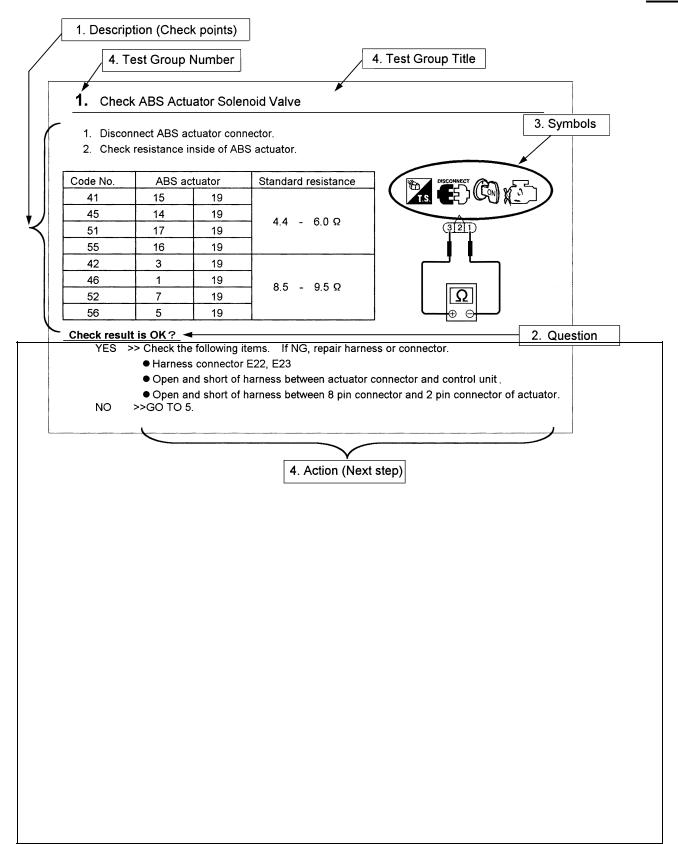
HOW TO USE THIS MANUAL
How to Follow Trouble Diagnoses |
AAS000NR |
DESCRIPTION |
|
NOTICE:
Trouble diagnoses indicate work procedures required to diagnose problems effectively. Observe the following instructions before diagnosing.
1.Before performing trouble diagnoses, read the “Preliminary Check”, the “Symptom Chart” or the “Work Flow”.
2.After repairs, re-check that the problem has been completely eliminated.
3.Refer to Component Parts and Harness Connector Location for the Systems described in each section for identification/location of components and harness connectors.
4.Refer to the Circuit Diagram for quick pinpoint check.
If you need to check circuit continuity between harness connectors in more detail, such as when a sub-harness is used, refer to Wiring Diagram in each individual section and Harness Layout in PG section for identification of harness connectors.
5.When checking circuit continuity, ignition switch should be OFF.
6.Before checking voltage at connectors, check battery voltage.
7.After accomplishing the Diagnostic Procedures and Electrical Components Inspection, make sure that all harness connectors are reconnected as they were.
HOW TO FOLLOW TEST GROUPS IN TROUBLE DIAGNOSES
SAIA0256E
1.Work and diagnostic procedure
Start to diagnose a problem using procedures indicated in enclosed test groups.
2.Questions and required results
Questions and required results are indicated in bold type in test group. The meaning of are as follows:
Revision: 2005 March |
GI-10 |
2005 X-Trail |

HOW TO USE THIS MANUAL
a. Battery voltage → 11 - 14V or approximately 12V
b. Voltage |
: Approximately 0V → Less than 1V |
3.Symbol used in illustration
Symbols included in illustrations refer to measurements or procedures. Before diagnosing a problem, familiarize yourself with each symbol. Refer to "Connector Symbols" in GI Section and "KEY TO SYMBOLS SIGNIFYING MEASUREMENTS OR PROCEDURES" below.
4.Action items
Next action for each test group is indicated based on result of each question. Test group number is shown in the left upper portion of each test group.
GI
B
C
HARNESS WIRE COLOR AND CONNECTOR NUMBER INDICATION
There are two types of harness wire color and connector number indication.
TYPE 1: Harness Wire Color and Connector Number are Shown in Illustration
●Letter designations next to test meter probe indicate harness wire color.
●Connector numbers in a single circle (e.g. M33) indicate harness connectors.
●Connector numbers in a double circle (e.g. F211) indicate component connectors.
AGI070
D
E
F
G
H
I
J
K
L
M
Revision: 2005 March |
GI-11 |
2005 X-Trail |

HOW TO USE THIS MANUAL
TYPE 2: Harness Wire Color and Connector Number are Shown in Text
SGI144A
KEY TO SYMBOLS SIGNIFYING MEASUREMENTS OR PROCEDURES
SAIA0750E
Revision: 2005 March |
GI-12 |
2005 X-Trail |
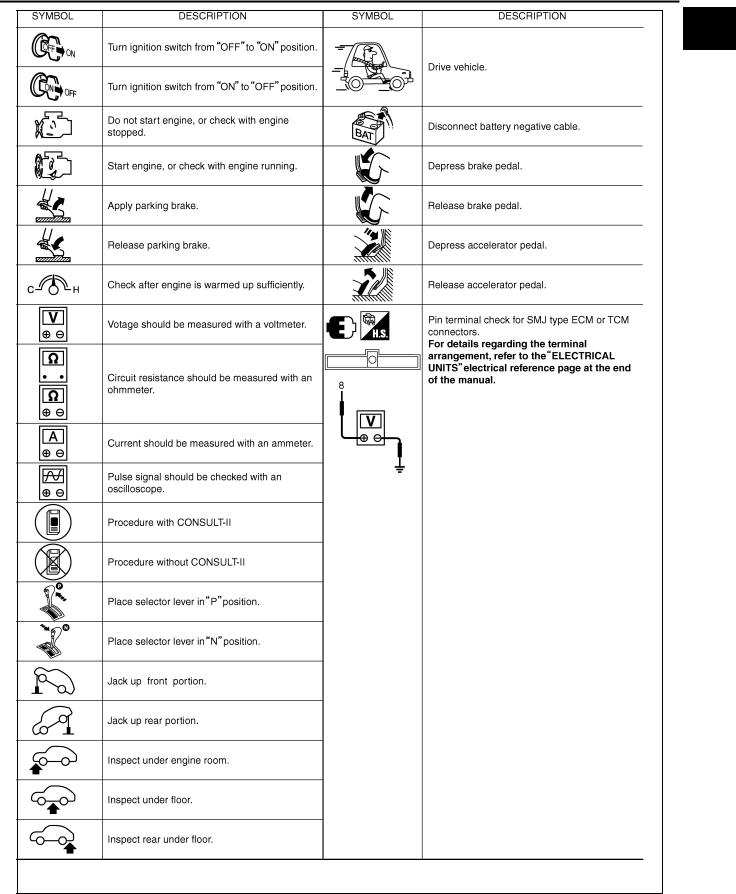
HOW TO USE THIS MANUAL
GI
B
C
D
E
F
G
H
I
J
K
L
M
SAIA0751E
Revision: 2005 March |
GI-13 |
2005 X-Trail |
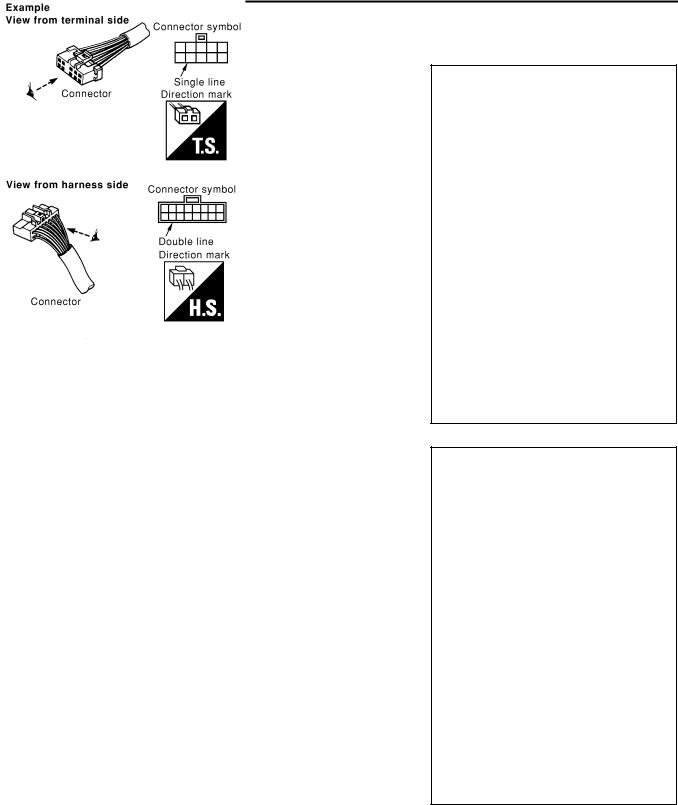
HOW TO USE THIS MANUAL
How to Read Wiring Diagrams |
AAS000NS |
CONNECTOR SYMBOLS
Most of connector symbols in wiring diagrams are shown from the terminal side.
●Connector symbols shown from the terminal side are enclosed by a single line and followed by the direction mark.
●Connector symbols shown from the harness side are enclosed by a double line and followed by the direction mark.
●Certain systems and components, especially those related to OBD, may use a new style slide-locking type harness connector. For description and how to disconnect, refer to PG section, “Description”, “HARNESS CONNECTOR”.
SAIA0257E
●Male and female terminals
Connector guides for male terminals are shown in black and female terminals in white in wiring diagrams.
SGI363
Revision: 2005 March |
GI-14 |
2005 X-Trail |
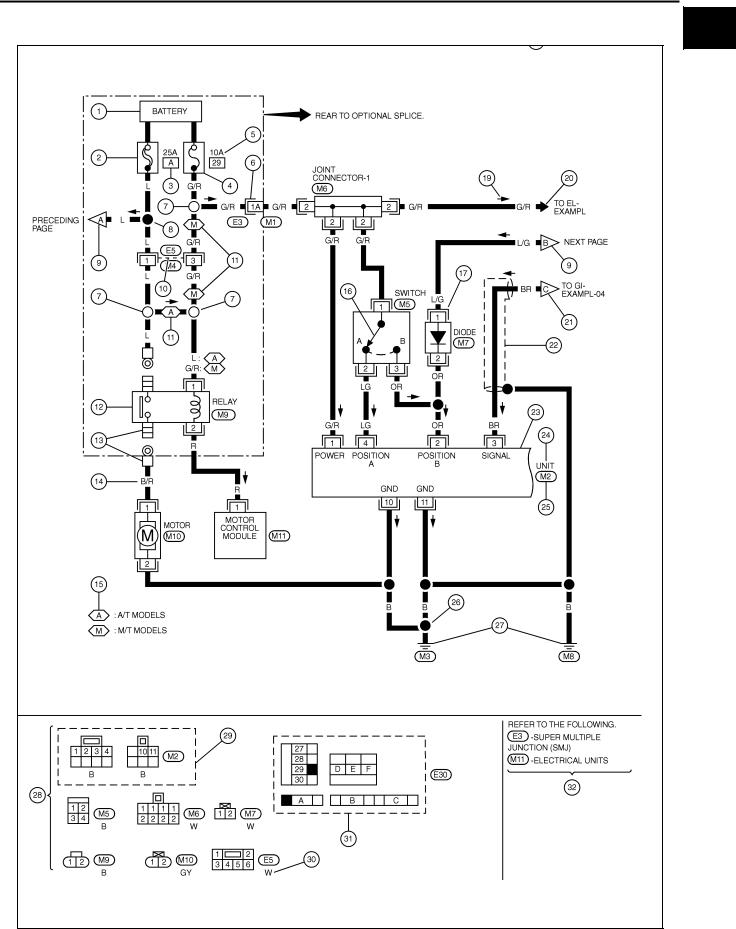
HOW TO USE THIS MANUAL
SAMPLE/WIRING DIAGRAM - EXAMPL - |
|
● For detail, refer to following “DESCRIPTION”. |
GI |
B
C
D
E
F
G
H
I
J
K
L
M
SGI091A
Revision: 2005 March |
GI-15 |
2005 X-Trail |

HOW TO USE THIS MANUAL
Optional Splice
SGI942
DESCRIPTION
Num- |
Item |
Description |
|
ber |
|||
|
|
||
|
|
|
|
1 |
Power condition |
● This shows the condition when the system receives battery positive voltage (can be oper- |
|
ated). |
|||
|
|
||
|
|
|
|
2 |
Fusible link |
● The double line shows that this is a fusible link. |
|
● The open circle shows current flow in, and the shaded circle shows current flow out. |
|||
|
|
||
|
|
|
|
3 |
Fusible link/fuse loca- |
● This shows the location of the fusible link or fuse in the fusible link or fuse box. For arrange- |
|
tion |
ment, refer to PG section, POWER SUPPLY ROUTING. |
||
|
|||
|
|
|
|
4 |
Fuse |
● The single line shows that this is a fuse. |
|
● The open circle shows current flow in, and the shaded circle shows current flow out. |
|||
|
|
||
|
|
|
|
5 |
Current rating |
● This shows the current rating of the fusible link or fuse. |
|
|
|
|
|
|
|
● This shows that connector E3 is female and connector M1 is male. |
|
6 |
Connectors |
● The G/R wire is located in the 1A terminal of both connectors. |
|
● Terminal number with an alphabet (1A, 5B, etc.) indicates that the connector is SMJ connec- |
|||
|
|
||
|
|
tor. Refer to PG section, SMJ (SUPER MULTIPLE JUNCTION). |
|
|
|
|
|
7 |
Optional splice |
● The open circle shows that the splice is optional depending on vehicle application. |
|
|
|
|
|
8 |
Splice |
● The shaded circle shows that the splice is always on the vehicle. |
|
|
|
|
|
9 |
Page crossing |
● This arrow shows that the circuit continues to an adjacent page. |
|
● The A will match with the A on the preceding or next page. |
|||
|
|
||
|
|
|
|
10 |
Common connector |
● The dotted lines between terminals show that these terminals are part of the same connector. |
|
|
|
|
|
11 |
Option abbreviation |
● This shows that the circuit is optional depending on vehicle application. |
|
|
|
|
|
12 |
Relay |
● This shows an internal representation of the relay. For details, refer to PG section, STAN- |
|
DARDIZED RELAY. |
|||
|
|
||
|
|
|
|
13 |
Connectors |
● This shows that the connector is connected to the body or a terminal with bolt or nut. |
|
|
|
|
Revision: 2005 March |
GI-16 |
2005 X-Trail |

|
|
|
HOW TO USE THIS MANUAL |
|||
|
|
|
|
|
|
|
|
|
|
|
|
|
|
|
Num- |
Item |
|
Description |
||
|
ber |
|
||||
|
|
|
|
|
||
|
|
|
|
|
||
|
|
|
● This shows a code for the color of the wire. |
|||
|
|
|
|
|
|
|
|
|
|
B = Black |
BR = Brown |
||
|
|
|
OR or O = Orange |
|||
|
|
|
W = White |
|||
|
|
|
P = Pink |
|||
|
|
|
R = Red |
|||
|
|
|
PU or V (Violet) = Purple |
|||
|
|
|
G = Green |
|||
|
|
|
GY or GR = Gray |
|||
14 |
Wire color |
L = Blue |
||||
SB = Sky Blue |
||||||
|
|
|
Y = Yellow |
|||
|
|
|
CH = Dark Brown |
|||
|
|
|
LG = Light Green |
|||
|
|
|
DG = Dark Green |
|||
|
|
|
|
|||
|
|
|
|
|
||
|
|
|
When the wire color is striped, the base color is given first, followed by the stripe color as shown |
|||
|
|
|
below: |
|
|
|
|
|
|
Example: L/W = Blue with White Stripe |
|||
|
|
|
|
|
||
15 |
Option description |
● This shows a description of the option abbreviation used on the page. |
||||
|
|
|
|
|
||
16 |
Switch |
● This shows that continuity exists between terminals 1 and 2 when the switch is in the A posi- |
||||
tion. Continuity exists between terminals 1 and 3 when the switch is in the B position. |
||||||
|
|
|
||||
|
|
|
|
|
||
17 |
Assembly parts |
● Connector terminal in component shows that it is a harness incorporated assembly. |
||||
|
|
|
|
|
||
18 |
Cell code |
● This identifies each page of the wiring diagram by section, system and wiring diagram page |
||||
number. |
|
|
||||
|
|
|
|
|
||
|
|
|
|
|
||
|
|
|
● Arrow indicates electric current flow, especially where the direction of standard flow (vertically |
|||
19 |
Current flow arrow |
downward or horizontally from left to right) is difficult to follow. |
||||
● A double arrow “ |
” shows that current can flow in either direction depending on cir- |
|||||
|
|
|
||||
|
|
|
cuit operation. |
|
|
|
|
|
|
|
|
||
20 |
System branch |
● This shows that the system branches to another system identified by cell code (section and |
||||
system). |
|
|
||||
|
|
|
|
|
||
|
|
|
|
|
||
|
|
|
● This arrow shows that the circuit continues to another page identified by cell code. |
|||
21 |
Page crossing |
● The C will match with the C on another page within the system other than the next or preced- |
||||
|
|
|
ing pages. |
|
|
|
|
|
|
|
|
||
22 |
Shielded line |
● The line enclosed by broken line circle shows shield wire. |
||||
|
|
|
|
|
||
23 |
Component box in |
● This shows that another part of the component is also shown on another page (indicated by |
||||
wave line |
wave line) within the system. |
|||||
|
|
|||||
|
|
|
|
|
||
24 |
Component name |
● This shows the name of a component. |
||||
|
|
|
|
|
||
|
|
|
● This shows the connector number. |
|||
|
|
|
● The letter shows which harness the connector is located in. |
|||
25 |
Connector number |
● Example: M : main harness. For detail and to locate the connector, refer to PG section "Main |
||||
|
|
|
||||
|
|
|
Harness", “Harness Layout”. A coordinate grid is included for complex harnesses to aid in |
|||
|
|
|
locating connectors. |
|
|
|
|
|
|
|
|
||
26 |
Ground (GND) |
● The line spliced and grounded under wire color shows that ground line is spliced at the |
||||
grounded connector. |
|
|
||||
|
|
|
|
|
||
|
|
|
|
|
||
27 |
Ground (GND) |
● This shows the ground connection. For detailed ground distribution information, refer to |
||||
"Ground Distribution" in PG section. |
||||||
|
|
|
||||
|
|
|
|
|
||
28 |
Connector views |
● This area shows the connector faces of the components in the wiring diagram on the page. |
||||
|
|
|
|
|
||
29 |
Common component |
● Connectors enclosed in broken line show that these connectors belong to the same compo- |
||||
nent. |
|
|
||||
|
|
|
|
|
||
|
|
|
|
|
||
|
|
|
● This shows a code for the color of the connector. For code meaning, refer to wire color codes, |
|||
30 |
Connector color |
Number 14 of this chart. |
|
|
||
|
|
|
|
|
||
|
|
Fusible link and fuse |
● This shows the arrangement of fusible link(s) and fuse(s), used for connector views of |
|||
31 |
"POWER SUPPLY ROUTING" in PG section. |
|||||
box |
||||||
|
|
The open square shows current flow in, and the shaded square shows current flow out. |
||||
|
|
|
||||
|
|
|
|
|
||
32 |
Reference area |
● This shows that more information on the Super Multiple Junction (SMJ) and Joint Connectors |
||||
(J/C) exists on the PG section. Refer to "Reference Area" for details. |
||||||
|
|
|
||||
|
|
|
|
|
|
|
GI
B
C
D
E
F
G
H
I
J
K
L
M
Revision: 2005 March |
GI-17 |
2005 X-Trail |
